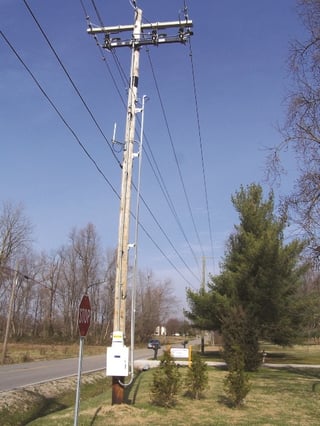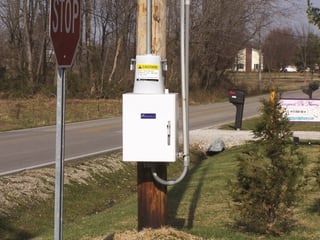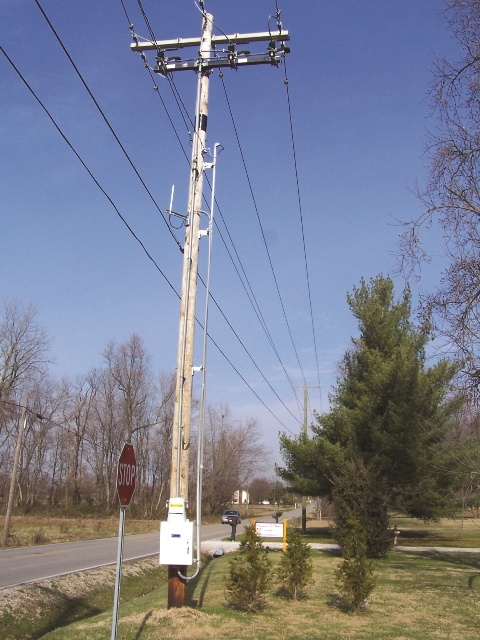"In the old configuration, if we lost either feeder, 750-800 customers were without power until a trouble-crew drove out to open and close the switches to isolate the outage and restore power," shared the utility.
Although the utility's transmission system was fully automated at the time, the electrical distribution system at Vectren Energy Delivery (based in Evansville, IN) was not. Their first foray into Distribution Automation (DA) — adding remotely operated motors to sectionalizing switches — took place in the fall of 2013.
Location, Location, Location
Vectren is an investor-owned gas and electric utility that serves ~142,000 electric customers in southwestern Indiana. Part of their responsibility is being prudent in their use of funds, so they chose the location for their DA pilot project carefully. The utility wanted the project to add immediate value, as well as provide a barometer of how other DA projects would impact the system. The chosen pilot project included automating switches on two circuits out of the newly constructed Libbert Substation. Here is why.
Load and System Configuration: Libbert was a new SCADA equipped substation serving a primarily suburban area with residential and commercial customers. Two, three-phase feeders come out of Libbert (Camelot and High Point) and each circuit served about 750-800 customers. Both were loop feeders since they connected with circuits from other substations through normally open switches.
In the old configuration, if the utility lost either feeder, 750-800 customers would be without power until a trouble-crew drove out to open and close the switches to isolate the outage and restore power. Portions of both circuits were vulnerable, especially to trees, and much load growth occurs in that area, making circuit capacity a concern. In fact, the substation was built to help serve the growing load.
SCADA and Communications: Although only about 5 0% of Vectren’s 93 distribution substations had SCADA, Libbert Substation circuits were chosen for the DA pilot because two of the three area substations are also SCADA-equipped. Using equipment at these neighboring substations, they could monitor the Libbert feeders within the pilot area.
The transmission lines into Libbert were constructed with OPGW (Optical Ground Wire) which served as the static for the lines and enables high speed communication via the fiber optics inside the cable. With this fiber back-bone, available bandwidth exceeded immediate needs. Since this was a pilot project, the probability of wanting additional monitoring points in the future was high.
From a data capacity standpoint, this was not a problem. The newly automated switches had mesh radios and an RTU installed in the motor operators that communicate with the master radio at the substation. The substation then forwarded the information to the dispatch center via the fiber. In addition to the radio system, the utility installed SCADA-enabled fault current indicators (FCI) on either side of the switches.
The systems communicate wirelessly with the RTU and provide information such as load current, voltage, and fault detection (among others). With this data, the dispatch operator is able to make intelligent and fast-response decisions.
Distance: Since Libbert Substation is remotely located from the utility's central office, they expected the project to reduce restoration time due to the reduction in driving times. Of course a crew was still needed to make repairs, but the switches could quickly minimize the size and the duration of the outage.
Bigger Plan
Once the utility knew what they wanted to achieve and decided on a location, the next step was selecting the motor operators. They used Hubbell’s AR switches for ten years and view Hubbell products at different conferences. Additionally, the Hubbell representative brought the ‘roadshow’ trailer to show them the equipment. Given this familiarity, it was practical to use an operator that the utility knew would work with otheir switches.
The switches provide outage/load information to the dispatch center, and a dispatch operator makes the decision to operate the switches or not. The system intelligence is expandable so that the system can be fully automated (ie.. self-healing) in the future, if desired.
In January 2014, they operated them during bitterly cold weather, a cross-arm on an adjacent circuit failed. We were able to transfer load onto one of the newly automated circuits. Since the outage was not on the automated circuit, a trouble-crew was sent to isolate those customers first. Dispatch was then able to remotely close one of the new switches to transfer the load to restore power. This was an advantage not considered. If a fault happens on certain nearby circuits, the utility can dispatch a trouble-man to just one location instead of two. It cuts the outage time by about 15 minutes.
Unfortunately, some network upgrades come in the face of a crisis. To find out how one of the nation’s largest diversified energy companies gained situational awareness needed to reduce power outage time after a major fire at one of its distribution substations, read our Aclara blog How to Modernize Your Distribution Network without Breaking a Sweat, or the Bank? Ask DTE Energy.


